A common classification of the Lepidoptera involves their differentiation into butterflies and moths. Butterflies are a natural monophyletic group, often given the suborder Rhopalocera, which includes Papilionoidea, Hesperiidae (skippers), and Hedylidae. In this taxonomic scheme, moths belong to the suborder Heterocera. Other taxonomic schemes have been proposed, the most common putting the butterflies into the suborder Ditrysia and then the "superfamily" Papilionoidea and ignoring a classification for moths.

Moths are a group of insects that includes all members of the order Lepidoptera that are not butterflies. They were previously classified as suborder Heterocera, but the group is paraphyletic with respect to butterflies and neither subordinate taxon is used in modern classifications. Moths make up the vast majority of the order. There are approximately 160,000 species of moth, many of which have yet to be described. Most species of moth are nocturnal, although there are also crepuscular and diurnal species.

The Sphingidae are a family of moths commonly called sphinx moths, also colloquially known as hawk moths, with many of their caterpillars known as hornworms. It includes about 1,450 species. It is best represented in the tropics, but species are found in every region. They are moderate to large in size and are distinguished among moths for their agile and sustained flying ability, similar enough to that of hummingbirds as to be reliably mistaken for them. Their narrow wings and streamlined abdomens are adaptations for rapid flight. The family was named by French zoologist Pierre André Latreille in 1802.

The Hepialidae are a family of insects in the lepidopteran order. Moths of this family are often referred to as swift moths or ghost moths.

Utetheisa is a genus of tiger moths in the family Erebidae. The genus was first described by Jacob Hübner in 1819.

Orgyia is a genus of tussock moths of the family Erebidae. The genus was described by Ochsenheimer in 1810. The species are cosmopolitan, except for the Neotropical realm.

Nepita is a monotypic moth genus in the subfamily Arctiinae erected by Frederic Moore in 1860. Its only species, Nepita conferta, the footman moth, was first described by Francis Walker in 1854. It is found in India and Sri Lanka.
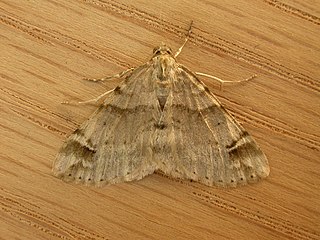
Syneora hemeropa, the ring-tipped bark moth, is a moth of the family Geometridae first described by Edward Meyrick in 1892. It occurs in eastern Australia from Queensland down to Tasmania.
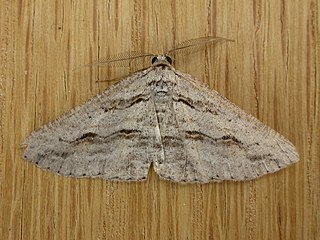
Syneora mundifera, the forest bark moth, is a moth of the family Geometridae first described by Francis Walker in 1860. It is found in Australia.
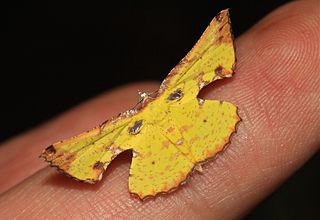
Corymica is a genus of moths in the family Geometridae described by Francis Walker in 1860.

Fascellina is a genus of moths in the family Geometridae described by Francis Walker in 1860.

Hypochrosis is a genus of moths in the family Geometridae. It was erected by Achille Guenée in 1857.
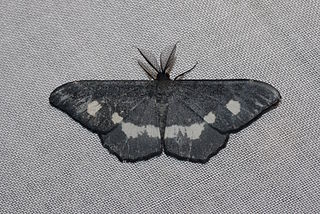
Hyposidra is a genus of moths in the family Geometridae first described by Achille Guenée in 1857.
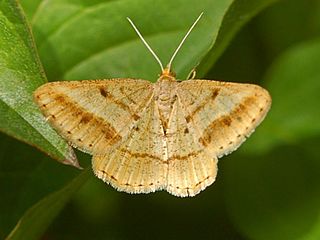
Isturgia is a genus of moths in the family Geometridae described by Jacob Hübner in 1823.

Sarcinodes is a genus of moths in the family Geometridae erected by Achille Guenée in 1857. The species are large with pinkish, mauvish or brownish-gray body and wings. The wings are traversed by between one and three oblique, straight fasciae. The forewing apex is acute, slightly falcate. The male antennae are unipectinate, those of the female are typically filiform, in some species unipectinate. The species are found in east Asia.

Syneora is a genus of moths in the family Geometridae erected by Alfred Jefferis Turner in 1917. All the species are found in Australia.

Ichneutica unica is a species of moth in the family Noctuidae. It is endemic to New Zealand and is found in the centre of the North Island and throughout the South Island. This moth is very similar in appearance to its close relatives Ichneutica phaula and Ichneutica toroneura. I. phaula can be distinguished as there is a difference in pectinations on the male antennae and I. toroneura can be distinguished as the black vein markings on the forewings is more uniform for that species in comparison to I. unica. I. unica is variable in appearance with the North Island specimens having a darker brown colour on the forewings and having a darker underside of the hindwings. This species inhabits open tussock grassland at various altitudes, coastal dunes, and inland volcanic dunes. Larvae feed on tussock grasses such as Chionochloa pallens and species in the genus Poa. Adult moths are on the wing from November to February and are attracted to both sugar and light traps.

Hyposidra talaca, the black looper or black inch worm, is a moth of the family Geometridae. The species was first described by Francis Walker in 1860. It is found from India to Indochina, Sundaland, Sulawesi, the Philippines, Sri Lanka, the Solomon Islands, Thailand, Taiwan, New Guinea and Australia, where it has been recorded from Queensland. It is a major defoliating pest in tea plantations.

Cleora scriptaria, the kawakawa looper moth, is a moth in the family Geometridae endemic to New Zealand.


















